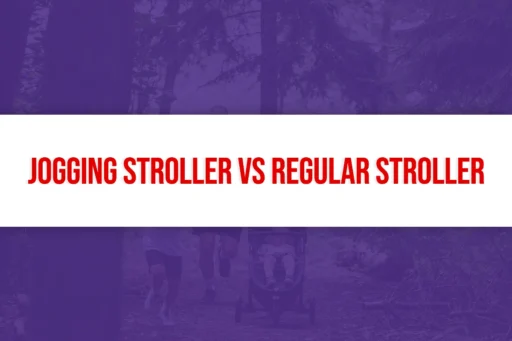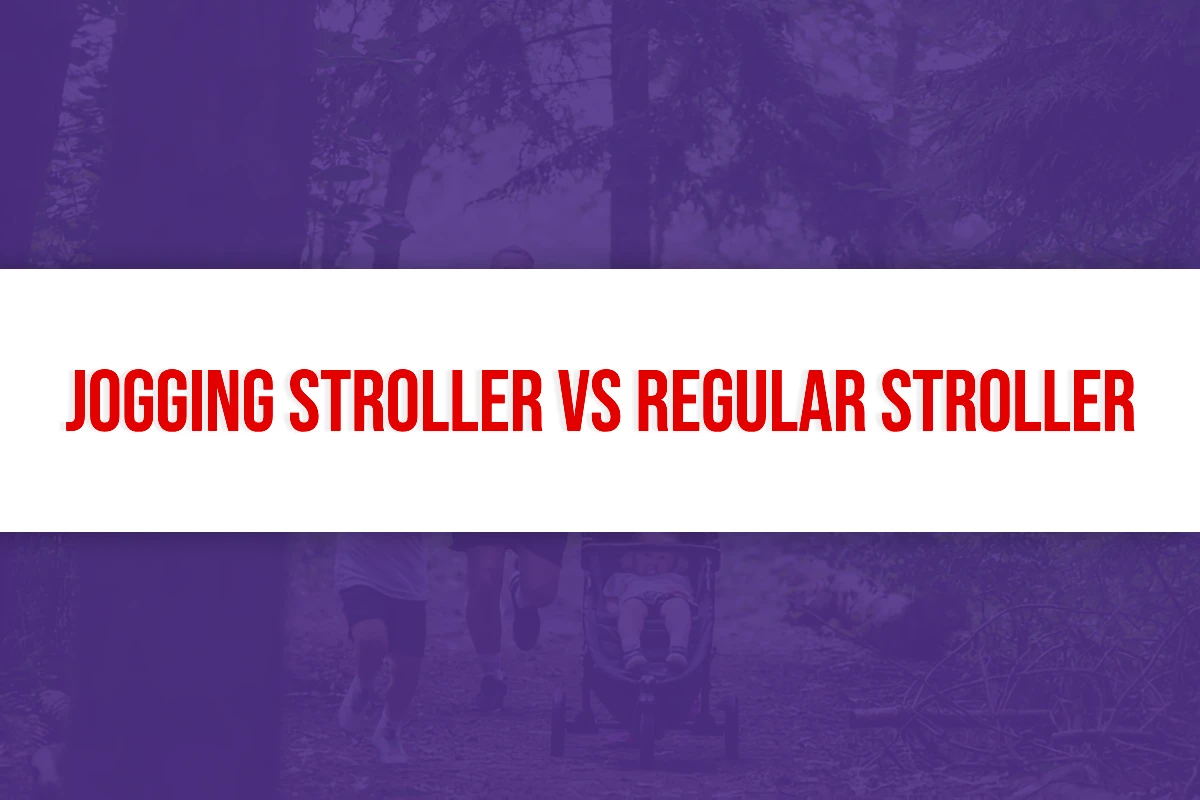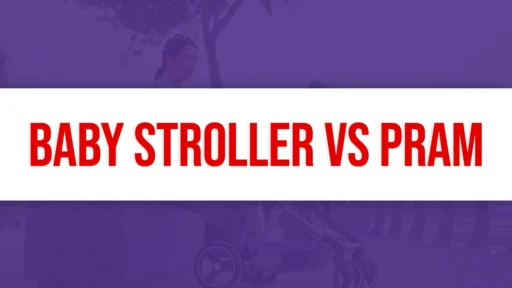Choosing the right stroller can be a challenge. Jogging strollers and regular strollers each have unique benefits.
Parents want the best for their children, and that includes picking the right stroller. Jogging strollers offer great stability and are perfect for active parents who enjoy jogging or running. On the other hand, regular strollers are versatile, convenient, and typically more affordable.
Understanding the differences between these two types can help you make an informed decision. In this blog, we will compare jogging strollers and regular strollers, considering their features, benefits, and potential drawbacks. This guide will help you determine which stroller type best suits your lifestyle and needs, ensuring comfort and safety for both you and your child.

Jogging Stroller Features
When choosing between a jogging stroller and a regular stroller, understanding the unique features of each is crucial. Jogging strollers are designed specifically for parents who want to stay active while taking their little ones along. In this section, we will delve into the key features that set jogging strollers apart.
Design And Structure
Jogging strollers are built with a sturdy frame to handle various terrains. They usually have a sleek, aerodynamic design to reduce wind resistance. The seats are often padded and recline to keep your child comfortable during the ride.
A key design element is the three-wheel configuration. This design provides better maneuverability and stability compared to traditional four-wheel strollers. The wheels are typically larger, which helps in navigating uneven surfaces.
Wheel And Suspension System
Wheels are a standout feature of jogging strollers. They usually have air-filled tires, similar to bicycle tires, which provide a smoother ride. The front wheel can be locked for running or swiveled for walking, offering flexibility based on your activity.
The suspension system in jogging strollers is designed to absorb shocks and bumps. This ensures a comfortable ride for your child, even on rough paths. It allows for better control and less jostling for your little one.
Safety Features
Safety is a top priority in jogging strollers. They come with a five-point harness to keep your child secure. This type of harness distributes the force of a sudden stop or jolt, minimizing the risk of injury.
Another important safety feature is the hand brake. This allows you to control the stroller’s speed, especially when going downhill. Additionally, jogging strollers often have a wrist strap to prevent the stroller from getting away from you.
Many jogging strollers also include a canopy to protect your child from the sun, rain, and wind. Reflective materials are often used to enhance visibility during early morning or evening runs.
Regular Stroller Features
Regular strollers come with various features designed to provide convenience, comfort, and safety. These features make them ideal for everyday use. Let’s explore some key aspects of regular strollers.
Design And Structure
Regular strollers typically have a sturdy frame made of aluminum or steel. They often feature a compact design for easy storage and transportation. Many models include a reversible seat that allows the baby to face either forward or backward. Some strollers also come with an adjustable handlebar to accommodate parents of different heights.
Comfort And Convenience
Comfort is a priority in regular strollers. They usually come with padded seats and reclining backrests for a cozy ride. A large canopy provides shade and protection from the elements. Many strollers also include a spacious storage basket for carrying baby essentials. Some models offer additional features such as cup holders and snack trays.
Safety Features
Safety is paramount in regular strollers. Most models are equipped with a five-point harness to keep the baby secure. They often have lockable front wheels for stability and parking brakes for added security. Many strollers also include reflective materials to enhance visibility during low light conditions.
| Feature | Description |
|---|---|
| Frame Material | Aluminum or Steel |
| Seat Orientation | Reversible |
| Storage | Spacious Basket |
| Safety Harness | Five-Point |
| Brakes | Parking Brakes |
Performance And Maneuverability
When choosing between a jogging stroller and a regular stroller, performance and maneuverability are key factors to consider. Each type of stroller offers unique advantages depending on your lifestyle and needs. This section will delve into how each stroller performs and maneuvers in different situations.
Jogging Stroller Performance
Jogging strollers are designed for parents who enjoy running or jogging. These strollers come with three large wheels that provide better stability and smoother rides over rough terrain. They often feature a front wheel that can swivel or lock in place. This helps to maintain balance and prevent tipping over at higher speeds.
Jogging strollers also have a hand brake for quick stops. This safety feature is essential when jogging downhill or in crowded areas. The suspension system in jogging strollers is advanced, ensuring a comfortable ride for your child even on bumpy paths.
Regular Stroller Performance
Regular strollers are more suited for everyday use. These strollers usually have four smaller wheels, making them easier to maneuver in tight spaces. They are perfect for navigating through malls, grocery stores, and sidewalks.
Regular strollers are generally lighter and more compact. This makes them easy to fold and store in your car or home. They do not have the specialized suspension systems found in jogging strollers, but they still offer a smooth ride on even surfaces.
| Feature | Jogging Stroller | Regular Stroller |
|---|---|---|
| Wheel Type | Three large wheels | Four small wheels |
| Suspension | Advanced suspension system | Basic suspension |
| Maneuverability | Good on rough terrain | Great in tight spaces |
| Brakes | Hand brake | Foot brake |
| Weight | Heavier | Lighter |
Usage Scenarios
Choosing between a jogging stroller and a regular stroller often depends on your lifestyle and daily activities. Understanding the key usage scenarios for each type can help you make an informed decision.
Ideal For Active Lifestyles
If you enjoy running or power walking, a jogging stroller can be a great choice. These strollers are designed to handle rough terrains and provide a smooth ride for your baby. They come with large wheels and excellent suspension systems, making them perfect for outdoor use.
Jogging strollers are also great for parents who want to maintain their fitness routines. You can take your baby along for a run in the park or on a trail. These strollers are built for speed and stability, allowing you to move quickly without compromising safety.
| Feature | Jogging Stroller |
|---|---|
| Wheel Size | Large |
| Suspension | Advanced |
| Terrain | Rough/Outdoor |
| Speed | High |
Perfect For Everyday Use
A regular stroller is ideal for daily activities like shopping, visiting friends, and casual walks. These strollers are lightweight and easy to maneuver in tight spaces. They are perfect for navigating crowded areas like malls or sidewalks.
Regular strollers often come with additional features like ample storage space and cup holders. This makes them convenient for carrying baby essentials. They are also easy to fold and store, making them perfect for families with limited space.
- Lightweight
- Easy to maneuver
- Ample storage
- Convenient for daily activities
Both jogging strollers and regular strollers have their own set of advantages. Your choice should align with your lifestyle and daily needs.
Pros And Cons
When choosing between a jogging stroller and a regular stroller, it’s essential to understand the pros and cons of each. This will help you make an informed decision that best suits your lifestyle and needs. Let’s delve into the advantages and disadvantages of both types of strollers.
Advantages Of Jogging Strollers
- Stability and Smooth Ride: Jogging strollers have large air-filled tires and suspension systems. This offers a smooth ride on various terrains.
- Enhanced Safety: These strollers often come with a handbrake and safety tether. This enhances control during runs.
- Comfortable for the Child: Jogging strollers usually have padded seats. This ensures a comfortable ride for your child.
- Great for Active Parents: They are perfect for parents who want to stay active. You can jog while spending time with your child.
Disadvantages Of Jogging Strollers
- Bulky and Heavy: Jogging strollers are generally larger and heavier. This makes them less convenient for everyday use.
- Higher Cost: These strollers are often more expensive. The advanced features come at a higher price.
- Limited Maneuverability: They are not as easy to maneuver in tight spaces. This can be challenging in crowded areas.
Advantages Of Regular Strollers
- Compact and Lightweight: Regular strollers are easier to carry and store. They fit well in small spaces and car trunks.
- Affordability: They are usually less expensive. This makes them accessible for many parents.
- Easy Maneuverability: Regular strollers are easier to navigate in tight spaces. This makes them ideal for shopping malls and busy streets.
- Variety of Designs: There is a wide range of styles and features. You can find one that suits your specific needs.
Disadvantages Of Regular Strollers
- Limited Terrain Use: Regular strollers are not suitable for rough terrains. They perform best on smooth surfaces.
- Less Stability: They lack the stability and smooth ride of jogging strollers. This can be less comfortable for the child.
- Fewer Safety Features: Regular strollers often lack advanced safety features. This includes handbrakes and suspension systems.
Cost Comparison
Cost Comparison: Choosing between a jogging stroller and a regular stroller? Consider the cost. This section compares the price ranges of both options, helping you decide which fits your budget better.
Price Range Of Jogging Strollers
Jogging strollers are designed for active parents. They offer durability and features suitable for running. But these benefits come at a cost. The price of jogging strollers varies widely.
- Basic Models: Basic jogging strollers start around $100 to $200.
- Mid-Range Models: Mid-range options range from $200 to $400.
- High-End Models: High-end jogging strollers can exceed $400.
Features like advanced suspension and lightweight frames affect the price. A table below summarizes the price ranges:
| Model Type | Price Range |
|---|---|
| Basic | $100 – $200 |
| Mid-Range | $200 – $400 |
| High-End | $400+ |
Price Range Of Regular Strollers
Regular strollers are more common. They offer convenience and come in various types. The cost can vary based on features and brand.
- Basic Models: Basic regular strollers start around $50 to $150.
- Mid-Range Models: Mid-range options range from $150 to $300.
- High-End Models: High-end regular strollers can exceed $300.
Additional features like extra padding and storage increase the cost. The following table outlines the price ranges:
| Model Type | Price Range |
|---|---|
| Basic | $50 – $150 |
| Mid-Range | $150 – $300 |
| High-End | $300+ |
Making The Right Choice
Choosing between a jogging stroller and a regular stroller depends on your lifestyle. Jogging strollers offer stability and smooth rides on rough paths. Regular strollers work best for everyday errands and indoor use.
Choosing between a jogging stroller and a regular stroller can be tough. Each type has its own benefits and drawbacks. The right choice depends on your specific needs and lifestyle.
Assessing Your Needs
First, think about where you will use the stroller. Do you plan to jog or run with it? If yes, a jogging stroller is the best choice. It has better suspension and stability. If you only need it for walks or trips to the mall, a regular stroller may be enough. Regular strollers are lighter and easier to fold. They are also often more affordable.
Considering Your Lifestyle
Your daily routine plays a big role in choosing a stroller. Active parents who run or jog need a jogging stroller. These strollers handle rough terrain well. They offer a smooth ride for the child. Parents who travel frequently may prefer a regular stroller. These strollers are more compact and easier to transport. They fit well in car trunks and on public transport. In short, your lifestyle will guide you to the best choice. Assess your needs and consider how you will use the stroller. This will help you make an informed decision. “`
Frequently Asked Questions
A jogging stroller is designed for running or jogging. It has three large wheels for stability and a suspension system for a smooth ride.
A regular stroller is meant for everyday use. It typically has four smaller wheels and is not built for high-speed activities like jogging.
Yes, jogging strollers can be used daily. They are versatile and can handle various terrains, making them suitable for regular use.
Jogging strollers are generally safe for infants over six months old. Always check manufacturer guidelines and use appropriate safety harnesses.
Conclusion
Choosing between a jogging stroller and a regular stroller depends on your needs. Jogging strollers are great for active parents. They handle rough terrains and provide stability. Regular strollers suit everyday use, offering comfort and convenience. Consider your lifestyle and activities.
Think about storage, ease of use, and budget. Both stroller types have their advantages. Your choice impacts your and your baby’s comfort. Make an informed decision for a happy strolling experience.







